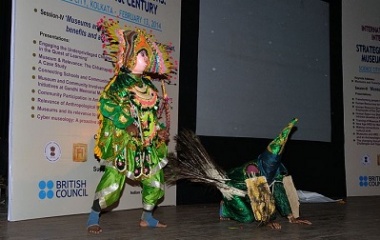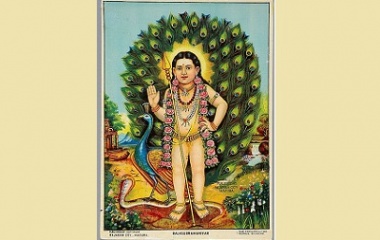Who Is Murugan?
Murugan, also known as Kartikeya (Kaa-rrttih-Keh-Yuw), is the son of Lord Shiva and the Goddess Pavathi. His brother is the infamous deity, Ganesha. Murugan is popularly worshipped in Southern India, especially in the Indian State of Tamilnadu. He is often referred to as Tamil Kadavul, which means The Lord of the Tamil people. He is considered to be the primary deity of the Kaumaram sect of Hinduism. Although this sect is primarily located in the Tamil region, there are also members in Sri Lanka and Malaysia.
The handsome Kartikeya is the commander of the army of Devas (Indian deities) and he is represented with six heads, enabling him to see in all directions at once. This means he can see any oncoming attack of war. He also has 12 hands and rides a peacock.
Origin
Newlyweds Lord Shiva and Goddess Parvathi lived together at Mount Gandhamadana. As they were enjoying their intimacy, a drop of Shiva’s fluid fell to the ground. Heat began to emerge from it, and it was so hot it seemed possible that it could engulf the whole world in flame. Agni (the fire god) disguised himself as a beggar, wandered in on the couple and devoured the spilled fluid in an effort to save the world.
Naturally, Parvathi was mortified and insulted at the intrusion. She cursed Agni; to paraphrase, she said, “You are going to get a terrible inflammation on your body from consuming that fluid, and from this day forward you will be an omnivore, and eat unclean things.”
Agni promptly developed unbearable inflammation all over his body. In his desperation, he asked Lord Shiva what he could do to rid himself of this awful curse. Shiva informed him that once the vital fluid was transferred to a woman, he would be relieved of his ailment.
Agni hid out in a deserted place, uncomfortably awaiting a suitable woman. Along came the six Kritikas. He transferred the fluid into all of their wombs, and all six women became pregnant. When their husbands found out, they were cursed, turned into stars and sent to the sky to form a constellation. Before they were transformed, however, each of them aborted their fetuses on a mountain in the Himalayas. The river Ganga carried the fetuses to a secluded place covered in reeds. After a while, Lord Murugan was born from the reeds with six heads, since he had six mothers.
The gods were rejoicing at the birth of this fantastic child. Parvathi collected the baby and asked Lord Shiva to let her keep the child as her own. Murugan grew to be a handsome and honorable man and he became the commander of the Devas and a great slayer of demons.
Family of Murugan
Lord Shiva, the father of Muragan, is the most powerful deity in the Hindu pantheon. He is a complex god, unique and supreme. For this reason, his shrine stands separately from the other gods in most temples.
Parvathi is the representation of the furious power of the male gods, and the personification of the divine energy of Lord Shiva. She is a destroyer of evil and a protector of the righteous.
The esteemed brother of Muragan is Ganesha. He has an elephant trunk and ears, and is one of the five prime Hindu deities along with his parents. He prevails over success, destroys evil and is a remover of obstacles. Although various gods are worshipped throughout the sects, all Hindus are devoted to Ganesha.
According to the legend, Murugan had two wives, Valli and Devasena. Valli stands for the power of will, and Devasena, the power of actions. Murugan represents the power of wisdom so the two wives completed him. Ironically, prior to marrying two wives, Murugan was known as Kumaraswami, which means bachelor god.
The Race for the Mango
An Indian sage brought a divine piece of fruit to Parvathi and told her the one who consumed it would have supreme knowledge and immortality. Parvathi thanked the sage and suggested that she would cut the fruit and divide it between her sons, Kartikeya and Ganesha, as she loved them both. The sage advised that the mango could not be shared and that only one brother would be able to consume it and reap the divine benefits.
Lord Shiva, in an effort to sort out the issue, decided to arrange a competition for settling the matter. He told the brothers that the one who could travel around the world three times and return first would be awarded the mango. Murugan didn’t want to waste a moment and immediately hopped on his peacock to begin his journey around the world.
The potbellied Ganesha knew he was no match for the warrior Muragan in a race. He also had no viable transportation as his mount was a mouse. He considered the situation, and then wise Ganesha began to circle his parents three times.
When Shiva and Parvathi asked why he was circling them, Ganesha explained to his parents that they were most dear to him and the center of his world. Within you is my universe, he said, so I am circling the world. He further explained that what one holds dear becomes the center of their life and all life energy.
Needless to say, his parents were honored and Ganesha won the race. He was awarded the divine mango and its blessings. Murugan was slightly disgruntled at being outsmarted, but he conceded as his brother had beaten him fairly. Murugan was aware that his strong point was his power and speed, while Ganesha’s strength was his intelligence.
In life we all follow different paths, in just the way Ganesha and Murugan did. Some of us learn by traveling and others learn by observing people.
Symbolism
Murugan rides a peacock, which is also the national bird of India. It symbolizes the destruction of harmful habits and control over sexual desires. The peacock is often depicted gripping its feet around a serpent, the symbol of ego and desire.
The divine spear (Vel) represents Murugan’s far reaching protection of the people.
Often, Murugan is depicted holding other weapons, and each is a pointer toward a better way of life.
His six heads correspond to the six attainments (siddhis) yogis aspire to along their spiritual path to enlightenment.
Modern Influence
The Six Abodes of Murugan are temples in Tamil specifically dedicated to him. In addition to his other popular name, Kartikeya, he is also referred to by the names Subramaniyam, Vadivela, Skanda, and Muruga in various temples. There are other temples dedicated to Muragan outside of India as well, including the famous Batu Caves in Malaysia.
Several Hindu festivals are dedicated to Muragan. Thaipusam is celebrated in the Tamil community during the month of Thai, which corresponds to a time in January or February depending on the year. The festival is a celebration and remembrance of when Parvati gave Murugan the divine spear with which he slayed evil demons. Vaikasi Visakam is another Tamil holiday, and is the birthday of Murugan.
Devout followers also observe a monthly fast dedicated to Murugan. Some show their dedication with a complete fast for 24 hours, while others observe by only eating a single meal. No non- vegetarian food is consumed during a fast.
Kanda Shasti is a six-day fast dedicated to Murugan. According to the legends, the gods were being tormented by demons led by Surapadma. Murugan defeated Surapadma after a six-day battle by slaying him with the spear he was gifted by his mother Parvathi. The fast is sacred and signifies Murugan’s consciousness within each person to triumph over the negativity in their mind and lead them on the path to success.











Bad Ganesha